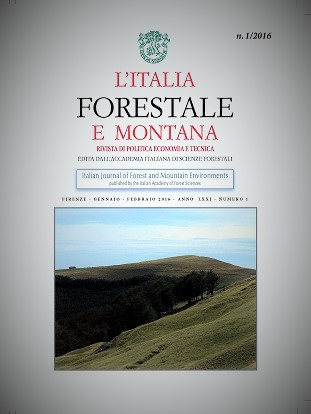First results on the structure and seed production of beech stands at the timberline in the Monti della Laga (Gran Sasso and Monti della Laga National Park)
Published 2016-05-10
Keywords
- timberline,
- forest structure,
- seed production,
- beech
Copyright (c) 2016 Italian Journal of Forest and Mountain Environments

This work is licensed under a Creative Commons Attribution-NonCommercial 4.0 International License.
Abstract
The aim of this work is to characterize the structure of beech stands at the timberline in the central Apennines (Gran Sasso and Monti della Laga National Park), and to analyze seed production and germination. Stand structure was analyzed using structural indexes with data collected in plots drawn out in beech stands along the timberline. Diameter growth was measured on a sample of trees felled by natural disturbances. During 2013, a good mast year, we analyzed seed production of these stands and germination rate in comparison to seed collected from stands growing at lower altitudes. Results showed that there are two main structural types which are still strongly impacted by grazing: single storied stands with big and very old trees (over 400 years, DBH>70 cm); and stands with complex structures where groups of old trees are mingled with multistoried patches formed by trees of different size and age. In all cases, dendrochronological analyses showed very slow diameter growth. Void seed percentage at the timberline was 82%, much higher than the one for seeds produced at lower altitudes (55%). Nevertheless, seed production in good years can be considered sufficient if compared to other Italian beech stands. We believe our study can be a useful starting point for a deeper and coordinated study on forest stand dynamics at the timberline, an area which is particularly delicate because very susceptible both to environmental and land use changes.

